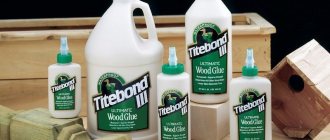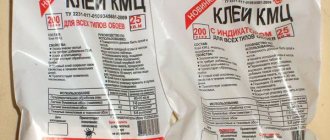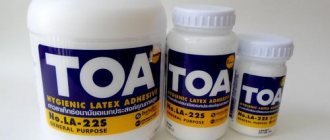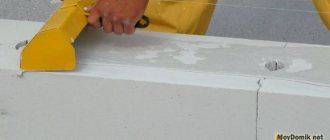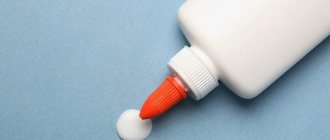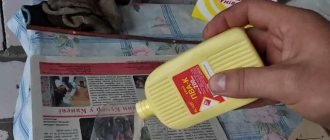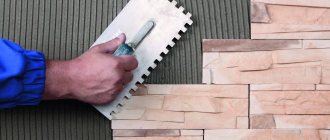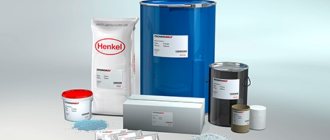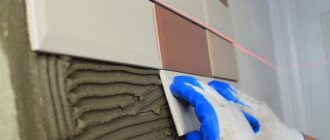Sooner or later, everyone encounters wallpapering, and everyone, as one, thinks that this is the simplest task. But when it’s time to get down to business, a lot of questions come to light. Among them, mainly, what wallpaper glue to choose and how to dilute it. This is the basis on which the entire quality of further work depends, and a thoughtful approach to its selection and practical application is the key to successful gluing.
No. 1. What should you consider when choosing wallpaper glue?
There are, to put it mildly, a lot of different adhesive compositions in stores. There are adhesives that need to be diluted from powder, there are ready-made compositions, there is even wallpaper with glue already applied (self-adhesive wallpaper). Adhesives also differ in composition. Some will glue the wallpaper the way you want - you can’t tear it off, but it will smell unpleasant and poison the air, others will be environmentally friendly, but will not be able to hold the canvas properly. To avoid mistakes when choosing, always consider the following factors:
- wall and wallpaper material;
- wallpaper weight;
- purpose of the room (what humidity and temperature will be in it);
- primary and final adhesion;
- mobility, which determines whether you can slightly adjust the position of the sheet on the wall;
- environmental Safety;
- the presence of antifungal components in the composition;
- moisture resistance;
- The pH should be within 6-7, otherwise yellow spots may appear on light-colored wallpaper;
- durability;
- the ability to restore adhesive properties after getting wet;
- glue consumption.
All these properties directly depend on the composition of the glue, so we immediately move on to studying it.
Review of manufacturers
Wallpaper adhesive is chosen not only by technical characteristics and purpose, but also by brand. Often this actually guarantees the quality of the product.
- Metylan non-woven premium is considered the best option for gluing non-woven wallpaper. It has high adhesion and is not afraid of mold.
- Exclusive Non-Woven - used on any surface, dries extremely evenly.
- FliziLex – based on modified starch. It is characterized by low cost and ease of use.
- Kleo is a composition for vinyl sheets. Has pronounced antiseptic properties.
No. 2. Composition of wallpaper glue
All adhesives have approximately the same composition - the difference in characteristics is achieved by changing the proportions.
Main components of wallpaper glue:
- basis, 50-95%. These are cellulose derivatives: methylcellulose (MC), carboxylmethylcellulose (CMC), or modified hydroxypropyl starch/carbomethyl starch (HPC/CMS);
- polyvinyl acetate (PVA), 5-50%. Increases glue adhesion and moisture resistance;
- fungicides and antiseptics, up to 3.4%. Protects against mold and mildew.
Always pay attention to the composition and ratio of components in it, as the properties of the glue depend on this.
Universal adhesives usually consist of 97% base and have a low content of antifungal additives. Adhesives for heavy coatings consist of 75% base and 23-25% PVA, which will ensure normal adhesion to the wall, the proportion of antiseptic additives is 0-3%. For the heaviest coatings (textile-based, glass wallpaper), adhesives are made that consist of equal amounts of base and PVA, and some antiseptics reach 3.4%.
Pay special attention to what type of base is used. If it is modified starch, then only paper and vinyl wallpaper can be glued with this glue. Carboxymethylcellulose (CMC) is considered the most tenacious; such adhesives are suitable for use on plastered and puttied surfaces. For gluing to a painted wall, it is better to use methylcellulose (MC)-based glue with a decent amount of PVA.
When gluing wallpaper in the bathroom and kitchen, be sure to use glue with the maximum content of bactericidal and fungicidal additives.
For fiberglass and fabric coverings
To glue glass wallpaper you need dispersed glue. The characteristics of such a mixture are quite high, because glass wallpaper is heavy, and ordinary mixtures will not hold them. Important parameters are frost resistance, which allows it to be stored in rooms with low or fluctuating temperatures, as well as moisture resistance, due to which it can be widely used in rooms with high humidity. Most adhesives for glass wallpaper have an environmentally friendly composition, are protected from fungi and do not cause allergic reactions.
No. 3. Types of wallpaper glue by purpose
All adhesive compositions can be divided into:
- universal;
- special, narrowly focused.
Universal adhesives are supposedly suitable for all types of wallpaper. When working with them, they follow the principle: the heavier the canvas, the thicker the composition must be kneaded. You can use universal glue either out of desperation or with light wallpaper. In other cases, it is better to take special compounds that are intended for a specific type of wallpaper (and sometimes also for certain operating conditions). Often the wallpaper manufacturer indicates the recommended adhesive on the packaging (this usually happens with photo wallpapers).
Let's look at some popular adhesive compositions found on store shelves:
- universal PVA is widely used in repair and finishing work, suitable for gluing paper and vinyl wallpaper. The composition is characterized by decent frost resistance, moisture resistance, adhesion and fire safety. There are no toxic substances in the composition, so the glue is completely safe;
- boostilate consists of KMC, latex, chalk, water and additives, is white or grayish in color, but when dried it becomes transparent. Moisture-resistant, has good mobility, fireproof, economical in consumption, does not yellow the canvas, and is environmentally friendly. Optimally suitable for paper wallpaper;
- drilling glue based on CMC, it has a pinkish tint, is odorless, and environmentally friendly;
- glue for vinyl wallpaper is produced on the basis of MC; cheaper analogues are produced on the basis of KMK/GPC, but the result with them will be questionable. MC-based adhesives have excellent adhesion, frost resistance, penetrating ability, durability and repeated adhesion;
- glue for non-woven wallpaper is applied to the wall and contains a large amount of antiseptic additives;
- adhesive for textile wallpaper and glass wallpaper has increased strength, the ability to withstand moisture, and is usually sold ready-made.
There is also a category of auxiliary adhesive compositions:
- joint adhesive used when gluing the edges of canvases, as well as seams in places of breaks. The composition is white, becomes transparent after drying, suitable for all types of wallpaper;
- acrylic border adhesive used for mounting decorative border strips on any base. The adhesive is highly durable and at the same time provides good glide, making adjustment easier.
However, there is still debate the advisability of using auxiliary compounds The border can be glued with PVA glue or the same composition that was used when installing the wallpaper. The joints will not peel off at all if the wallpaper installation technology is not violated. As a last resort, you can glue them with bustylate, which will become transparent after drying.
Characteristics of wallpaper glue
A high-quality composition for wallpapering must have certain properties, which we will consider in detail:
- Environmental friendliness and harmlessness are the main requirements for wallpaper glue. Since the type of wall covering in question is used for interior decoration, and most often for wall decoration in living rooms, the adhesive should not release toxic substances into the atmosphere. Fortunately, most modern products are made from harmless components and are considered environmentally friendly.
- The glue should dissolve well in water, forming a homogeneous mass without clots or lumps.
- Wallpaper glue does not dry out too quickly and, when diluted, can be stored for several days if you close the container with a lid and place it in a cool room.
- The above-mentioned feature is also good because the strip glued to the wall can be shifted and moved along the surface for some time. This allows you to straighten the drawing, correct some defects, and achieve an ideal result.
- Most wallpaper adhesives can be used as a primer for plastered walls if these walls are subsequently going to be covered with wallpaper.
Before you buy wallpaper glue, you should familiarize yourself with its characteristics. What you should pay attention to before purchasing material, we will consider below:
- The degree of adhesion of the adhesive composition is a very important characteristic, since it determines how firmly the wallpaper will stick to the wall. This indicator is determined by the component composition of the mixture, in particular, the amount of polyvinyl acetate if we are talking about vinyl glue. There are two types of adhesion: initial and final. Initial means the adhesion force of the material to the wall at the moment of contact. Final adhesion determines the degree of adhesion of the wallpaper to the surface after the glue has dried. As a rule, such an indicator in a numerical designation is not contained on a pack of glue, but there you can certainly find information like this: “The composition has high adhesive ability” or “Glides well after contact with the wall.” PVA-based compounds have the highest degree of adhesion; methylcellulose also has good adhesive ability; modified starch has the lowest value.
- The second characteristic that you should pay attention to is the compatibility of the glue with the type of surface on which you plan to glue the wallpaper. Many manufacturers indicate similar information on product packaging. Often, wallpaper adhesive is suitable for applying it to wood, concrete, plastered, and metal surfaces.
- When choosing an adhesive, you need to find out the amount of fungicides contained in the component composition of the substance. It is advisable that such additives should not exceed 3%, since an excess of fungicides can adversely affect health.
- The acid-base indicator of the mixture is also important. The pH level should be 6-7 units, then you can be sure that yellow spots will not appear on the wallpaper.
- There is another useful characteristic - the moisture resistance of the glue. This ability is useful if the wallpaper will be glued in a very damp room, for example, in the bathroom or kitchen.
- Wallpaper glue should be non-toxic, environmentally friendly and not emit an unpleasant odor.
No. 4. Should I take it ready-made or dilute it with water?
Wallpaper glue can be sold in two formats:
- ready-to-apply adhesive;
- powder that must be diluted with water.
to use a ready-made composition , since you don’t have to waste time, even if it’s a little, on studying the instructions for preparing the glue and directly on the preparation itself. Ready-made glue is sold in buckets and costs a little more than dry glue. When purchasing, carefully monitor the expiration date, since the glue can remain in a liquid state for a relatively short time.
Dilute the dry mixture with water - one of the simplest tasks in repair. It is enough to follow the instructions and add a strictly defined amount of water, mix thoroughly and let the glue “simmer” for a while, unless otherwise indicated on the package. In general, just follow the instructions. This type of glue is the most popular.
For beginners, there are glues that are colored blue or pink . This is necessary so that you do not miss a centimeter while wallpapering. After drying, the composition becomes transparent. Such glues cost more than regular ones and are in demand, but not all beginners realize that there is no point in such colored glue. The fact is that when applying regular glue, wallpaper sheets become a little darker, and uncoated areas are easy to determine without any indication.
Wallpaper that already has a layer of glue on it deserves special attention . To activate it, you need to peel off the protective film and/or moisten it a little. There is no need to take a bucket, dilute glue, use rollers and wait for the glue to dry. But self-adhesive wallpaper is more expensive than regular wallpaper and is very thin, so the surface will have to be prepared especially carefully.
Wallpaper glue consumption
Almost all manufacturers indicate the approximate consumption of glue on its packaging, but such information is often not true. The fact is that, depending on the specific conditions of use, the consumption of the substance may be much more or less than indicated in the instructions.
The type of wallpaper is an important point to consider when diluting glue with water. The heavier and denser the material, the thicker the adhesive composition should be. However, even in such a situation, you can reduce the consumption of the substance if you carry out the preparatory work correctly. Using 2 layers of primer instead of one, as well as using materials from the same manufacturer, will reduce glue consumption by about a third.
The structure of the surface covered with wallpaper also affects the cost of glue. Porous and rough materials will require more solution than smooth and dense materials.
Let's look at the approximate glue consumption using vinyl wallpaper as an example:
- If the surface needs to be pre-primed, the dry mixture is diluted with water in a ratio of 1:40. This means that a standard pack weighing 300 g needs to be dissolved in 12 liters of water. This amount of glue will be enough to prime about 100 m² of walls.
- When gluing vinyl, textile or structural wallpaper, the mixture must be made quite thick. The standard 300 g of dry powder must be diluted in 6 liters of water, that is, in a ratio of 1:20. This amount of glue can cover approximately 35-40 m².
- For thin paper wallpaper, the glue may not be so thick; a 300-gram pack can be diluted in 9 liters of water and covered with the composition from 45 to 50 m² of surface.
No. 5. Type of wallpaper and type of glue
The easiest way is to just take the glue that the manufacturer indicated on the wallpaper packaging. What if there are compounds that are no worse (or even better!), but much cheaper. You shouldn’t blindly trust recommendations, because you can use your head yourself and choose the right wallpaper adhesive based on the type of wallpaper.
So, which wallpaper glue is better to choose, taking into account the wallpaper material:
- paper wallpapers are distinguished by minimal paddle, so for gluing them, a composition based on CMC, universal glue, as well as ordinary PVA, drilling glue and even homemade paste are suitable;
- Vinyl wallpaper is a little heavier than paper wallpaper, but the principle of gluing is the same - the glue is applied to the canvas, and not to the wall. Vinyl does not allow air to pass through, which affects the drying speed of the glue, so homemade paste is not used in this case - only a special one based on MC will do. As a last resort, you can use universal glue, but it is necessary to prepare a solution of maximum concentration. If the base of the wallpaper is non-woven, then it is better to take the composition for non-woven wallpaper;
- Non-woven wallpaper requires the use of a special adhesive without alternative, which is applied to the wall, due to which the consumption of the product is minimal. It is better not to use universal composition and paste;
- fabric and glass wallpaper are glued to particularly strong special compounds;
- photo wallpaper Often get a self-adhesive backing, otherwise use vinyl wallpaper glue.
Comparison table of technical characteristics
This rating contains the best wallpaper adhesives today.
| Model | Purpose | Consumption | Water consumption |
| Quelyd Special interlining | for vinyl wallpaper, for non-woven wallpaper, for paintable wallpaper | non-woven - 0.15 kg/sq.m, for painting - 0.13 kg/sq.m | non-woven - 16.5 l/kg, for painting - 15 l/kg |
| KLEO EXTRA Non-woven | for non-woven wallpaper | 0.18 – 0.2 kg/sq.m | 24 l/kg |
| Metylan Interlining Ultra Premium | for non-woven wallpaper, for paintable wallpaper | on a non-woven smooth base - 0.16 - 0.17 kg/sq.m, on a non-woven textured base - 0.15 - 0.19 kg/sq.m | on a non-woven smooth base - 20 l/kg, on a non-woven textured base - 18 l/kg |
| Moment Interlining | for non-woven wallpaper | 0.15 – 0.2 kg/sq.m | 15.5 l/kg |
| ACM Adhesiva U Universal | for vinyl wallpaper, for non-woven wallpaper, for paper wallpaper | paper - 0.12 kg/sq.m, lightweight vinyl - 0.15 kg/sq.m, non-woven - 0.17 kg/sq.m | paper - 23 l/kg, lightweight vinyl - 20 l/kg, non-woven - 16 l/kg |
| Oscar Ready to use | for glass wallpaper and fiberglass | 0.2 – 0.25 kg/sq.m | 18 l/kg |
| Metylan Universal Premium | for vinyl wallpaper, for paper wallpaper | paper - 0.16 - 0.18 kg/sq.m, vinyl - 0.15 - 0.18 kg/sq.m | paper - 30 l/kg, vinyl - 20 l/kg |
Below is a detailed description.
No. 6. How to prepare wallpaper glue?
Store-bought compounds have almost replaced homemade adhesives, but the recipes have not yet been forgotten and are still used by the people. Often such compositions are used by older people. In some cases, it is indeed better to prepare the paste yourself rather than buy a store-bought compound. For example, when you need to make simple repairs in a country house and hang the cheapest paper wallpaper, or when the store-bought composition was literally not enough for one roll.
The paste is very easy to prepare:
- boil water in a large container (you can take a bucket);
- In a separate small container, mix flour with a small amount of water. The solution should have the consistency of thick sour cream and be free of lumps;
- For 1 liter of water (the one that boils in a bucket) take 6 tbsp. spoons of flour;
- When the water has boiled, carefully pour the flour mixture into it, stirring vigorously to prevent the formation of lumps. If they still appear, then you will have to strain the paste through a sieve;
- When the paste has cooled, you can start gluing. 1 liter of this glue is enough to glue 2-3 rolls of wallpaper on average.
You can use starch instead of flour. The proportion will be slightly different: 10 liters of water will take 1 kg of potato starch. The cooking principle is the same. First, the starch is poured with a small amount of warm water, mixed, and added in a thin stream to boiling water. The mixture is boiled a little, filtered and left to cool. You can add dry wood glue to the mixture; 100 g will be enough. It will improve the adhesiveness. The shelf life of compositions based on flour and starch is a day, so there is no need to prepare them too much for future use.
Some craftsmen even make their own PVA glue , although it is quite inexpensive in stores. Still, situations are different, so if something happens, you can refer to the following recipe:
- 5 g of photographic gelatin is poured into 1 liter of distilled water and left to swell for 1 day;
- place the resulting substance in a water bath, add 100 g of flour and stir thoroughly until the composition becomes homogeneous;
- after 5 minutes, add 20 ml of ethyl alcohol and 4 g of glycerin;
- the mixture is removed from the water bath, cooled and used for its intended purpose.
PVA glue, by the way, is used not only when you need to glue something. Sometimes it is diluted with water and used as a primer - it is a budget alternative to ready-made compounds.
Using wallpaper glue
Surface preparation and adhesive preparation
Before diluting the wallpaper glue with water, you need to prepare the wall. This process consists of several stages:
- First of all, the surface should be cleaned of the old coating. The old wallpaper needs to be soaked with water and removed with a spatula, the tiles can be knocked down, and the paint can be removed with a solvent.
- After this, the cleaned walls are carefully leveled, cracks and cracks are sealed with plaster, all protrusions are knocked down and polished with sandpaper. Then the walls can be leveled with putty and sanded again with fine-grained sandpaper.
- The next stage is priming the walls. For this purpose, it is best to use the same glue that will subsequently be used to glue the wallpaper.
- After the primer has dried, you can proceed to further steps: preparing strips of wallpaper and diluting the adhesive mass.
Wallpaper glue is diluted with water in accordance with the instructions that come with the product. To prepare the solution, select a deep enamel or plastic container and fill it with the required amount of water. Use cold water, as warm water may cause the glue to clump together. Pour dry powder into cold water in a thin stream, constantly stirring the solution.
To mix the glue efficiently, it is convenient to use a construction mixer or a special attachment that fits on a drill. If you don’t have such tools at hand, you can stir the mixture with a wooden stick. It is convenient to prepare the adhesive composition together: one person pours the powder, the second mixes the liquid.
After preparation, the glue must stand for about 15 minutes to acquire the necessary properties. Then the mass should be mixed again, after which it will be ready for use.
Wallpapering a wall
If thin paper wallpaper is used to decorate the room, glue should only be applied to the wall. If you also smear the paper, it may get wet and tear. When working with all other types of materials, glue is applied both to the wall and to the wallpaper strip.
It is most convenient to apply the glue with a wide flat brush or paint roller. It is very important that there are no dry spots left on the surface to be treated. Many modern adhesive compositions acquire a pink tint after dissolution, which allows you to control the quality of their application. This color disappears after drying.
When the wall is moistened with glue, you need to wait 5 minutes, and then start gluing the wallpaper strip. Heavy wallpaper may take up to two days to dry. While the coating is drying on the wall, you should not open the windows in the room or allow even the slightest draft, otherwise the material will peel away from the surface.
No. 7. The best manufacturers of wallpaper adhesives
If you do not rely on folk recipes and trust only industrially produced adhesives, then before going to a hardware store you need to know the state of things on the market. You can see almost identical compositions on the shelves, but how can you determine which wallpaper glue is best? In this case, you need to rely not on intuition, but on the reputation of the manufacturer and reviews of its products.
Among the largest and most reliable manufacturers of wallpaper glue, it is worth highlighting:
- Kleo – French brand adhesives. The range includes compositions for any type of wallpaper, as well as universal glue. We also produce a composition for beginners (with an indicator), ready-made glue and glue for finishing children's rooms;
- Metylan are German adhesives that are distinguished by their excellent quality, large assortment and high price. It was this company that was the first to produce pink adhesives. Today the manufacturer offers compositions for all types of wallpaper, universal adhesives, as well as glue for wallpaper joints;
- PUFAS - another market giant. The German company produces compositions for various types of wallpaper, incl. for velor, metallized and wood fiber based. There is a series of compounds with increased moisture resistance, as well as a number of completely environmentally friendly compounds;
- Quelyd – French adhesives, presented in a wide range. Powder in closed packaging has an unlimited service life. In addition to a number of special compounds, there is glue with an indicator, adhesives with fungicidal properties and glue for treating joints;
- Semin is a French company with several factories in Russia. The range is not as wide as that of competitors, but the quality is high and the price is slightly lower;
- Exclusive - English compositions with increased strength and moisture resistance, well suited for heavy velor and metal wallpaper;
- ACM – Italian adhesives, presented in universal and specialized compositions, characterized by a reduced amount of volatile substances;
- Bostik and Axton are French compounds that are well known to domestic buyers for their high quality;
- "Moment" - adhesives of a German brand, which are now produced in domestic factories. There are universal compounds with fungicides, adhesives for non-woven and vinyl wallpapers, adhesives with an indicator, glue for joints and high-strength glue;
- Quality is a domestic brand that produces several lines of adhesives in different price categories. The assortment includes universal and special formulations;
- Oscar and Decoro adhesives are also produced in Russia and are intended for heavy wallpaper.
Average prices on the market
When choosing wallpaper glue, many buyers pay attention to its price. Here the variability of prices reaches 10 times the value. For the same wallpaper it can range from 60 rubles. per pack 300 g, up to 600 rub. for similar packaging. The price depends on the country of origin and brand recognition, which guarantees high quality glue.
The average price for a pack of glue weighing 300 g in St. Petersburg is 300 rubles. But there is a small nuance here. Moment glue is produced in Russia, so it is cheaper than similar types of foreign production.
The vast majority of Russians consider it a purely Russian product and often prefer imported glue. In fact, this is German glue, produced on German equipment, using German technology, their own recipe and raw materials. It built the plant and controls production.
Buying ready-made, already diluted glue will cost about 3 times more. If your budget allows, such a purchase will help avoid some problems when breeding it.
The most budget-friendly option is to prepare the adhesive mass yourself from flour, starch, or make PVA glue at home.
What glue to use for paper wallpaper
Paper wallpaper belongs to the category of “light” wallpaper. Therefore, when you come to a specialized store, ask the seller for a package marked “For gluing light wallpaper.”
Paste for paper wallpaper
Do not forget about such a traditional and long-familiar composition for gluing as paste . After preparation, it must be used completely, since after a while it begins to lose its adhesive qualities. This composition is prepared, as a rule, from a mixture of starch and flour. You can choose either potato or corn starch.
| Rice. 3. Paste - wallpaper glue that you can make yourself |
Do not allow the solution to become too thick, as this may complicate the work process. However, even if this happens, you can add a little hot water while stirring the solution.
It is important to cook the paste until it is completely ready so that its adhesive properties are maximized. It is recommended to use a fine sieve to filter out lumps and foreign matter, as well as to form a more homogeneous mixture.
CMC mixture for paper wallpaper
One of the most common compositions for gluing paper canvases is CMC , due to its acceptable quality and low cost. The glue visually appears as a white or slightly yellowish powder with long shelf life. The mixture is prepared in enamel containers.
By the way, CMC has another important advantage, especially in comparison with paste. After cooking, it is not necessary to use its entire volume at once. The remaining mixture can be used throughout the week, provided it is stored in a closed container.
| Rice. 4. CMC glue for wallpaper - cheap and high quality |
TOP 3 adhesives for glass wallpaper
Fiberglass wallpaper is a wall covering made from fiberglass. Their properties resemble non-woven ones, however, they have even less plasticity.
This type of wallpaper necessarily requires the use of specialized glue. The three best options will be discussed below.
Oscar for fiberglass wallpaper
Oscar for fiberglass wallpaper
Adhesive composition for gluing fiberglass wallpaper. It is supplied ready-made in a bucket with a volume of 10 liters.
According to the instructions, this adhesive mixture is suitable for many types of wallpaper, not only fiberglass. You just need to dilute it with water.
The main advantage of this option is its strength. This glue will reliably hold the glass wallpaper on the wall for many years.
pros
- high quality of the finished mixture;
- good performance;
- frost resistance;
- multifunctionality.
Minuses
- relatively high price;
- high consumption.
Oscar for fiberglass wallpaper
KLEO ULTRA for glass wallpaper
KLEO ULTRA for glass wallpaper
This inexpensive glue for glass wallpaper can be purchased in packages that contain about half a kilogram of dry mixture. It is enough for 10 liters of solution.
The glue preparation time is about five minutes. A pack of glue, by the way, is designed to treat about 50 m2 of surface.
A distinctive feature of the model is its inertness to paints, which indicates the possibility of using glass wallpaper as a basis for further painting.
pros
- high-quality gluing;
- easy to apply to the surface;
- low consumption;
- guarantee against mold.
Minuses
- high price;
- the need to clean up stains almost immediately;
- difficult to clean after drying.
KLEO ULTRA for glass wallpaper
PUFAS Glutolin GTX Rubin
PUFAS Glutolin GTX Rubin
Universal adhesive from Pufas, which contains methylcellulose. It is suitable for all types of wallpaper, including fiberglass.
It is convenient to work with such glue - it does not stain the wallpaper, is quickly prepared, and does not have an unpleasant odor. If applied correctly, the wallpaper will last a very long time.
Important! This glue has been shown to be highly resistant to lime and cement.
pros
- quickly prepares for application;
- high quality;
- resistance to frost, lime and cement;
- multifunctional.
Minuses
- low efficiency.
PUFAS Glutolin GTX Rubin
You might be interested in learning how to estimate how many rolls of wallpaper you need .
